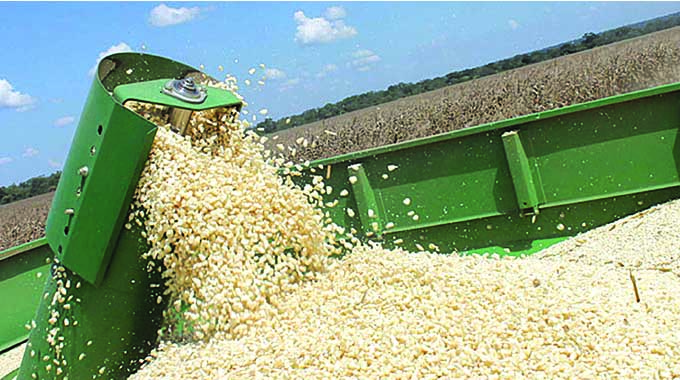Food security assured as Zim records surplus

Elita Chikwati Features Editor
ZIMBABWE will have a surplus of 107 328 tonnes of cereals despite the decline in production during the 2021/22 summer cropping season, the Ministry of Lands, Agriculture, Fisheries and Rural Development has said.
According to the Ministry ‘s Second Crop and Livestock Assessment report, the country is expected to harvest an estimated 1 557 914 tonnes of maize and 194 100 tonnes of traditional grains for the 2021/22 summer cropping season.
Although there has been a decrease in cereal production from last year’s harvest, when taking into consideration the amount of maize and traditional grains in the Strategic Grain Reserve (SGR), Zimbabwe will still have a surplus, the Ministry said. “The total cereal production is 1 752 014 tonnes against a national requirement of 2 267 599 tonnes (1 817 599 tonnes for human consumption and 350 000 tonnes for livestock). As at April 17, the country had 447 294 tonnes of maize and 75 619 tonnes of traditional grains in the SGR.
“There is a surplus of 107 328 Mt after considering Strategic Grain Reserve (SGR),” read the report. Lands, Agriculture, Fisheries, Water and Rural Development Deputy Minister Vangelis Haritatos said the grain in the SGR could be used to mitigate against the deficit. “Furthermore, several months ago we opened for the imports of maize for millers who have access to free funds to also import their deficit requirements. We assure the nation that the food situation is our top priority and there will certainly not be any shortages,” he said.
Deputy Minister Haritatos attributed the decline in cereal production to erratic rainfall experienced during the 2021/22 cropping season.
“Climate change has affected our country’s production of grain.
“Our Ministry has been pushing hard on irrigation development with a target to ensure that we have 350,000 hectares under irrigation which will ensure that we are food and nutrition self-sufficient,” he said.
Ministry Permanent Secretary, Dr John Basera, also confirmed the surplus. “We have managed to secure for the nation enough grain stocks for human and livestock consumption on account of current 2021/22 production and yesteryear surplus. The livestock sub-sector performed incredibly well as most of the KPIs are in the positive.
“We all know we could have done much better given the teamwork, plans in place, the dedication and unity of purpose, but Covid-19, climate change and the geopolitical dynamics worked against our favour. But, be that as it may, it only make us more resolute in our determination to achieve food self-sufficiency, import substitution and inclusive agricultural transformation, ultimately,” he said.
The Second Crop and Livestock Assessment report shows that maize production declined by 43 percent from the 2 717 171 tonnes produced in the 2020/2021 season while traditional grains production also declined by 44 percent from 347 968 tonnes last season to 194 100 tonnes this year.
“Sorghum production is expected to be 144 633 tonnes which is 41 percent lower than 244 063 tonnes obtained during 2020/2021 season.
“Pearl millet production is expected to be at 44 143Mt which is 51 percent less than 90 683 tonnes obtained during 2020/2021. Finger millet production is expected to be at 5 320 tonnes which is a 60 percent decrease from 13 223 tonnes produced in the 2020/2021 season,” said the report.
The 2021/2022 season started late in the second and third dekad of December 2021 in most parts of the country. Where it started early, (last week of October to mid- November 2021), it was a false start.
Rainfall distribution was poor in both space and time across the country. There were incessant rains in January followed by a prolonged dry spell in the first week of February to end of March.
The false start of the season resulted in failed crop establishment forcing most farmers to replant several times. The late onset caused late plantings which were later affected by the prolonged dry spell at the reproductive stage causing write offs especially in the central and southern parts of the country.
During April unusually heavy late rains were received which were expected to benefit the late planted crop, but the incessant rains caused excessive leaching of nitrogen and other crop nutrients.










Comments